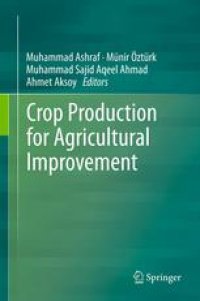
Ebook: Crop Production for Agricultural Improvement
- Tags: Agriculture, Plant Sciences, Plant Genetics & Genomics, Plant Physiology, Plant Biochemistry
- Year: 2012
- Publisher: Springer Netherlands
- Edition: 1
- Language: English
- pdf
In the recent years, the looming food scarcity problem has highlighted plant sciences as an emerging discipline committed to devise new strategies for enhanced crop productivity. The major factors causing food scarcity are biotic and abiotic stresses such as plant pathogens, salinity, drought, flooding, nutrient deficiency or toxicity which substantially limit crop productivity world-wide. In this scenario, strategies should be adopted to achieve maximum productivity and economic crop returns. In this book we have mainly focused on physiological, biochemical, molecular and genetic bases of crop development and related approaches that can be used for crop improvement under environmental adversaries. In addition, the adverse effects of different biotic (diseases, pathogens etc.) and abiotic (salinity, drought, high temperatures, metals etc) stresses on crop development and the potential strategies to enhance crop productivity under stressful environments are also discussed.
In the recent years, the looming food scarcity problem has highlighted plant sciences as an emerging discipline committed to devise new strategies for enhanced crop productivity. The major factors causing food scarcity are biotic and abiotic stresses such as plant pathogens, salinity, drought, flooding, nutrient deficiency or toxicity which substantially limit crop productivity world-wide. In this scenario, strategies should be adopted to achieve maximum productivity and economic crop returns. In this book we have mainly focused on physiological, biochemical, molecular and genetic bases of crop development and related approaches that can be used for crop improvement under environmental adversaries. In addition, the adverse effects of different biotic (diseases, pathogens etc.) and abiotic (salinity, drought, high temperatures, metals etc) stresses on crop development and the potential strategies to enhance crop productivity under stressful environments are also discussed.
In the recent years, the looming food scarcity problem has highlighted plant sciences as an emerging discipline committed to devise new strategies for enhanced crop productivity. The major factors causing food scarcity are biotic and abiotic stresses such as plant pathogens, salinity, drought, flooding, nutrient deficiency or toxicity which substantially limit crop productivity world-wide. In this scenario, strategies should be adopted to achieve maximum productivity and economic crop returns. In this book we have mainly focused on physiological, biochemical, molecular and genetic bases of crop development and related approaches that can be used for crop improvement under environmental adversaries. In addition, the adverse effects of different biotic (diseases, pathogens etc.) and abiotic (salinity, drought, high temperatures, metals etc) stresses on crop development and the potential strategies to enhance crop productivity under stressful environments are also discussed.
Content:
Front Matter....Pages i-vii
Front Matter....Pages 17-17
Bridging Genomic and Classical Breeding Approaches for Improving Crop Productivity....Pages 19-41
Breeding for Improved Drought Tolerance....Pages 43-56
Breeding for Biotic Stress Resistance/Tolerance in Plants....Pages 57-114
The American Halophyte Prosopis strombulifera, a New Potential Source to Confer Salt Tolerance to Crops....Pages 115-143
Breeding for Biotic Stress Tolerance in Plants....Pages 145-200
Breeding Wheat for Salt Tolerance and Stem Rust Resistance....Pages 201-216
The Potential of Breeding Okra (Abelmoschus esculentus L.) for Water Stress Tolerance....Pages 217-235
Front Matter....Pages 237-237
Biotechnology as an Aid for Crop Improvement to Overcome Food Shortage....Pages 239-261
Plant Genetic Engineering: Problems and Applications....Pages 263-290
Transcriptomics and Proteomics Analysis of Root Nodules of Model Legume Plants....Pages 291-315
Progress and Prospects for Efficient Micropropagation of Woody Plants....Pages 317-361
Novel Methods in Micropropagation of Pistachio....Pages 363-377
Crop Productivity and Water Use Efficiency: The Role of Carbon Isotope Discrimination Technique....Pages 379-393
Behaviour of Plant Pathogens for Crops Under Stress During the Determination of Physiological, Biochemical, and Molecular Approaches for Salt Stress Tolerance....Pages 395-416
Biochemical and Molecular Aspects of Drought Tolerance in Wheat Triticum L. Genotypes....Pages 417-441
Molecular Basis of Disease Resistance in Cereal Crops: An Overview....Pages 443-476
Polyamines: Role in Plants Under Abiotic Stress....Pages 477-489
Front Matter....Pages 491-512
Crop Diversification Practices in Saskatchewan, Canada....Pages 513-513
Crop Improvement Through Different Means: Challenges and Prospects....Pages 515-522
Front Matter....Pages 1-15
Invasive Weed Species – A Threat to Sustainable Agriculture....Pages 513-513
An Overview of Plant Growth Promoting Rhizobacteria (PGPR) for Sustainable Agriculture....Pages 523-556
Arbuscular Mycorrhizae for Sustainable Agriculture....Pages 557-579
A Site-Specific Potassium Fertilization Approach to Overcome Sporadic Response of Crops....Pages 581-618
Optimal Supply of Micronutrients Improves Drought Tolerance in Legumes....Pages 619-636
Potential of Rhizobia for Sustainable Production of Non-legumes....Pages 637-657
Effect of Drip and Subsurface Drip Irrigation with Saline Water on Tomato Crop....Pages 659-704
Lipid and Carbohydrate Metabolism of Cowpea (Vigna unguiculata L. Walp) Cultivars in Relation to Temperature Stress....Pages 705-719
A Review on Barley Yellow Dwarf Virus....Pages 721-745
Back Matter....Pages 747-782
....Pages 783-796